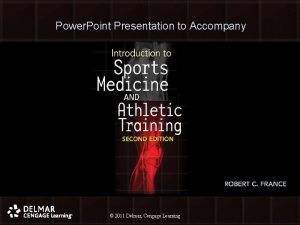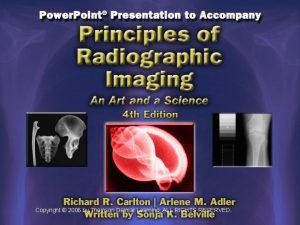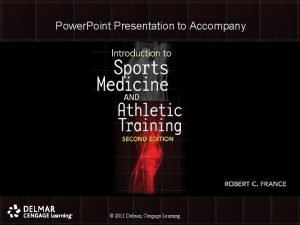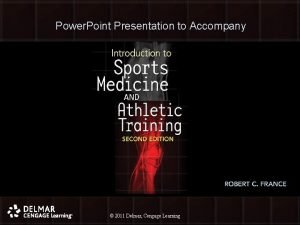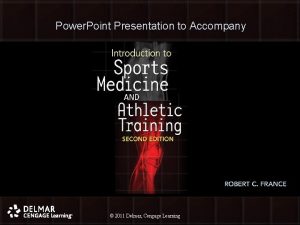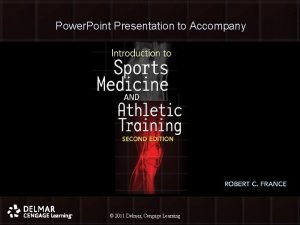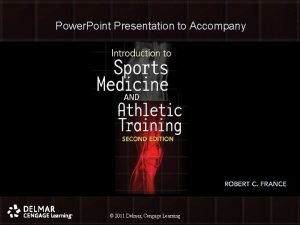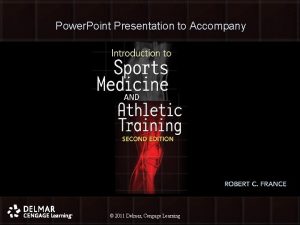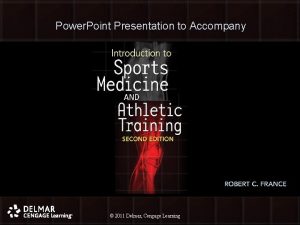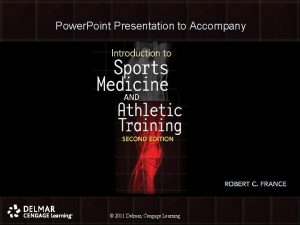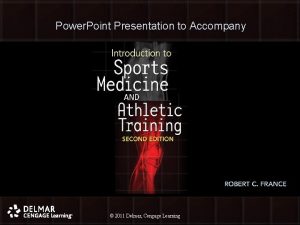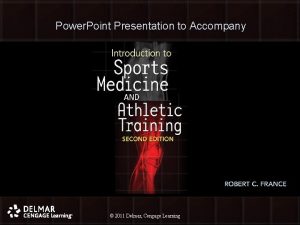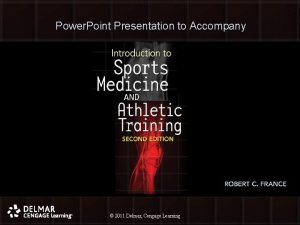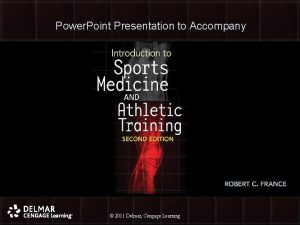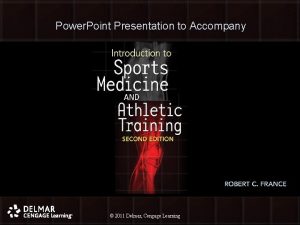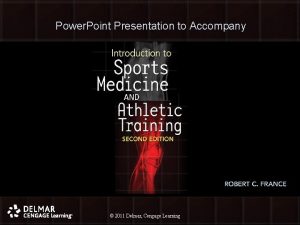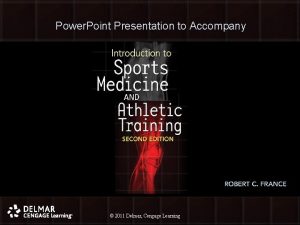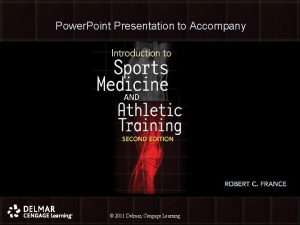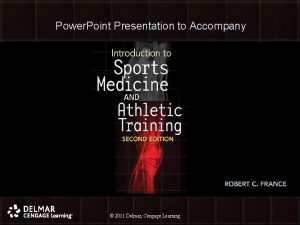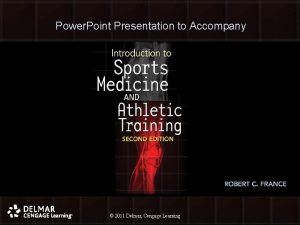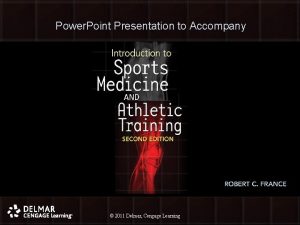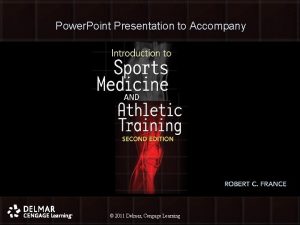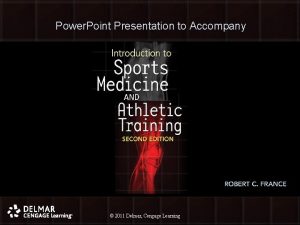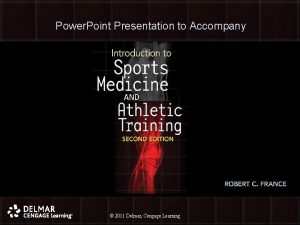Power Point Presentation to Accompany 2011 Delmar Cengage
























- Slides: 24

Power. Point Presentation to Accompany © 2011 Delmar, Cengage Learning © 2010 Delmar, Cengage Learning

Chapter 25 Special Considerations in Athletes © 2011 Delmar, Cengage Learning © 2010 Delmar, Cengage Learning 2

Objectives • Upon completion of this chapter, you should be able to: – Explain how climate affects athletic performance – Describe the difference between heat exhaustion and heatstroke – Explain the five ways the body loses heat – Describe how to treat hypothermia and hyperthermia © 2011 Delmar, Cengage Learning © 2010 Delmar, Cengage Learning 33

Objectives (cont’d. ) • Upon completion of this chapter, you should be able to (cont’d. ): – Explain how different skin conditions are exacerbated by athletics – Explain the effects of diabetes and how it can be managed – Explain how epilepsy affects the body – Explain a systemic reaction to an insect bite – Describe the female athlete triad © 2011 Delmar, Cengage Learning © 2010 Delmar, Cengage Learning 44

Special Considerations in Athletics • Each athlete brings unique conditions or concerns – Important for the athletic staff to know – Range from previous injuries to potentially lifethreatening allergies to bee stings – Training staff needs to be aware so they can be prepared © 2011 Delmar, Cengage Learning © 2010 Delmar, Cengage Learning 55

Environmental Conditions and Athletic Participation • Stress – Heat stress – Hypothermia • Athletes need to be well hydrated, rested, and in good physical condition • To reduce body temperature move the victim to a cool location, remove unnecessary clothing, and pour cool water over extremities © 2011 Delmar, Cengage Learning © 2010 Delmar, Cengage Learning 66

Environmental Conditions and Athletic Participation (cont’d. ) • Dehydration – On average, we lose between three and six liters of water daily • One hour of exercise can demand a 50% increase water amount the body uses – Three levels: mild, moderate, severe • Sunburn – Ultraviolet (UV) light can lead to skin cancer and premature aging © 2011 Delmar, Cengage Learning © 2010 Delmar, Cengage Learning 77

Environmental Conditions and Athletic Participation (cont’d. ) • Heat cramps – May signal first stage of heat illness – Occur most commonly in calf muscles • May also affect quadriceps, hamstrings, or abdominal muscles • Heat syncope (fainting) – Occurs when body attempts to cool itself by dilating blood vessels to speed up evaporation © 2011 Delmar, Cengage Learning © 2010 Delmar, Cengage Learning 88

Environmental Conditions and Athletic Participation (cont’d. ) • Heat exhaustion – Near-total body collapse – Mild form of heat illness • Heatstroke – Most severe heat-related condition – Involves a breakdown of the body’s heatregulation mechanism © 2011 Delmar, Cengage Learning © 2010 Delmar, Cengage Learning 99

Environmental Conditions and Athletic Participation (cont’d. ) • Cold stress – Body loses heat through: respiration, evaporation, conduction, radiation, and convection © 2011 Delmar, Cengage Learning © 2010 Delmar, Cengage Learning 1010

Environmental Conditions and Athletic Participation (cont’d. ) • Wind chill – Rate of heat loss resulting from combined effect of low temperature and wind • Hypothermia – Body heat is lost faster than can be replaced • May be impending, mild, moderate, or severe • Frostbite – Skin tissue and blood vessels are damaged from exposure to temperatures below 32°F © 2011 Delmar, Cengage Learning © 2010 Delmar, Cengage Learning 1111

Skin Conditions in Athletes • Acne mechanica – Acne that results from heat, pressure, occlusion, and friction • Plantar warts – Small, hard growths on the bottom of the foot • Herpes gladiatorum – Herpes simplex infection transmitted through skin-to-skin contact © 2011 Delmar, Cengage Learning © 2010 Delmar, Cengage Learning 1212

Skin Conditions in Athletes (cont’d. ) • Fungal infections – Tinea pedis: fungal infection that thrives in warmth and dampness • Blisters – Friction, heat, and moisture increases risk – Tear occurs within upper skin layers, forming a space into which that fluid seeps © 2011 Delmar, Cengage Learning © 2010 Delmar, Cengage Learning 1313

Skin Conditions in Athletes (cont’d. ) • Abrasions – Normally caused by poorly fit equipment or rubbing of skin • Jogger’s nipples – Constant chafing between a runner’s nipples and shirt causes painful, crusted lesions that bleed © 2011 Delmar, Cengage Learning © 2010 Delmar, Cengage Learning 1414

Diabetes • Disease in which the body does not produce or properly use insulin – A hormone needed to make cells absorb sugar from blood • Genetics and environmental factors (e. g. , lack of exercise) appear to play roles © 2011 Delmar, Cengage Learning © 2010 Delmar, Cengage Learning 1515

Diabetes (cont’d. ) • Type 1 diabetes – Results from the body’s failure to produce insulin • Type 2 diabetes – Occurs when the body still makes insulin but: • Does so in insufficient amounts or • Produces insulin that does not function properly © 2011 Delmar, Cengage Learning © 2010 Delmar, Cengage Learning 1616

Diabetes (cont’d. ) • Diabetic emergencies – Insulin reaction • Occurs when there is too much insulin in the body – Diabetic coma • Occurs when there is too much sugar and too little insulin in the blood © 2011 Delmar, Cengage Learning © 2010 Delmar, Cengage Learning 1717

Seizure Disorders • Disruptions of normal brain activity – Epilepsy: seizures recur regularly – Other causes include: • Infections, high fever, brain tumors, drugs, strokes, bleeding in the brain, trauma to the brain, and low blood glucose, sodium, or calcium © 2011 Delmar, Cengage Learning © 2010 Delmar, Cengage Learning 1818

Seizure Disorders (cont’d. ) • Types: – Simple partial seizure • Jerking begins in one area of the body • Cannot be stopped, but person stays awake and aware – Generalized tonic-clonic seizures • Characterized by a sudden cry, falling, and rigidity, followed by muscle jerks, shallow breathing or temporarily suspended breathing, bluish skin, and possible loss of bladder or bowel control © 2011 Delmar, Cengage Learning © 2010 Delmar, Cengage Learning 1919

Insect Bites and Stings • Two greatest risks: – Allergic reactions • Local • Systemic – Infections • Epinephrine injection is the only effective immediate treatment © 2011 Delmar, Cengage Learning © 2010 Delmar, Cengage Learning 2020

The Female Athlete Triad • Combination of: – Disordered eating – Amenorrhea (lack of menstrual periods) – Osteoporosis © 2011 Delmar, Cengage Learning © 2010 Delmar, Cengage Learning 2121

The Female Athlete Triad (cont’d. ) • Warning signs: – Frequent or unexplained injuries – Excessive or compulsive exercise – Change in performance – Impaired concentration – Absent or irregular menstrual periods – Restrictive eating – Use of weight-loss products or supplements © 2011 Delmar, Cengage Learning © 2010 Delmar, Cengage Learning 2222

Conclusion • Many health and safety factors that must be taken into account when participating in athletics – Factors (e. g. , the environment) can turn a positive situation into a dangerous one • Understanding causes of environmental-related illnesses helps the athlete plan ahead and stay within safe limits © 2011 Delmar, Cengage Learning © 2010 Delmar, Cengage Learning 2323

Conclusion (cont’d. ) • Other concerns are specific medical conditions that may limit or curtail athletic competition – The athlete must be made aware of illnesses and conditions that can affect their performance and health – Quick recognition and treatment will ensure good health and optimal performance © 2011 Delmar, Cengage Learning © 2010 Delmar, Cengage Learning 2424
 Delmar cengage learning medical terminology
Delmar cengage learning medical terminology 2009 delmar cengage learning
2009 delmar cengage learning Medical terminology chapter 1 learning exercises answers
Medical terminology chapter 1 learning exercises answers Measuring and recording apical pulse
Measuring and recording apical pulse 2009 delmar cengage learning
2009 delmar cengage learning 2009 delmar cengage learning
2009 delmar cengage learning 2009 delmar cengage learning
2009 delmar cengage learning Delmar cengage learning instructor resources
Delmar cengage learning instructor resources Things that accompany salvation
Things that accompany salvation Accompany chapter 1
Accompany chapter 1 Median cubital vein
Median cubital vein Inkjet printers are considered legacy technology
Inkjet printers are considered legacy technology Topics for powerpoint presentation for class 4
Topics for powerpoint presentation for class 4 Power point presentation design west vancouver
Power point presentation design west vancouver Delmar isotonic
Delmar isotonic Delmar tsi
Delmar tsi Delmar international (thailand) co. ltd
Delmar international (thailand) co. ltd Delmar thomson learning
Delmar thomson learning Borgify
Borgify Triangle of power
Triangle of power Powerbi in powerpoint
Powerbi in powerpoint Point point power
Point point power Cengage learning chapter 7 answers
Cengage learning chapter 7 answers Cengage differential equations
Cengage differential equations Bank reconciliation cengage
Bank reconciliation cengage














